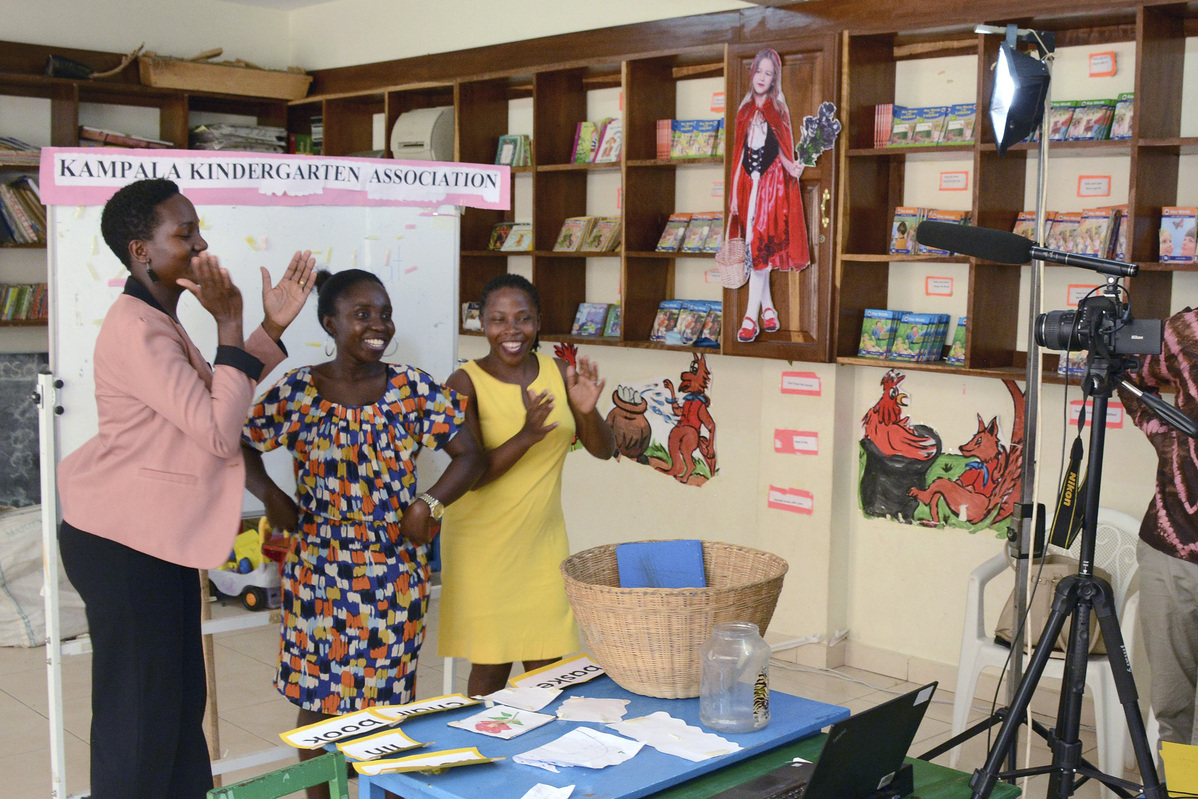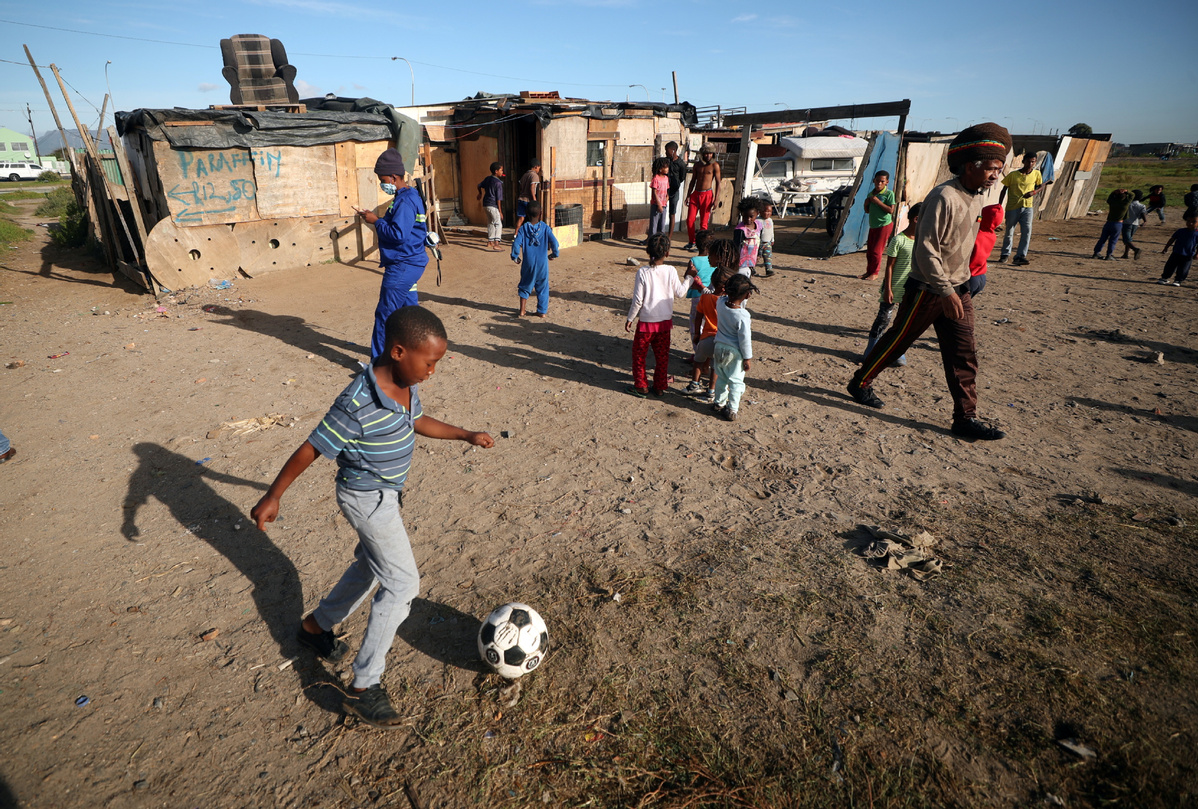联合国儿童基金会最新报告显示,在新冠疫情期间,至少三分之一的儿童无法进行远程学习,导致了“全球教育紧急状况”。

Kindergarten teachers perform during an online class in Kampala on Saturday. As a measure to contain the spread of COVID-19, schools have started to offer online classes in Uganda. NICHOLAS KAJOBA/XINHUA
At least a third of the world’s schoolchildren – 463 million children globally – were unable to access remote learning when COVID-19 shuttered their schools, according to a new UNICEF report released on August 26 as countries across the world grapple with their ‘back-to-school’ plans.
根据联合国儿童基金会8月26日发布的一份新报告,在新冠疫情导致学校关闭期间,全球学龄儿童中有至少三分之一(4.63亿)无法进行远程学习。全球各国正尽力按计划让学生重返校园。
“For at least 463 million children whose schools closed due to COVID-19, there was no such a thing as remote learning,” said Henrietta Fore, UNICEF Executive Director.
联合国儿童基金会执行主任亨丽埃塔·福尔说:“至少有4.63亿儿童在因为疫情关闭学校后根本没有接受远程教育。”
“The sheer number of children whose education was completely disrupted for months on end is a global education emergency. The repercussions could be felt in economies and societies for decades to come.”
“连续数月完全无法接受教育的儿童数量之多,导致了全球教育紧急状况。在未来几十年里,经济和社会都会感受到由此带来的影响。”
repercussion [ˌriːpəˈkʌʃn] n.反响;令人不满意的后果
At the height of nationwide and local lockdowns, around 1.5 billion schoolchildren were affected by school closures. The report outlines the limitations of remote learning and exposes deep inequalities in access.
在全国性和地方性封锁措施最严厉的时候,近15亿儿童受到学校停课的影响。该报告概述了远程学习的局限性,并暴露了在获取远程教育方面的严重不平等。
The report uses a globally representative analysis on the availability of home-based technology and tools needed for remote learning among pre-primary, primary, lower-secondary and upper-secondary schoolchildren, with data from 100 countries. Data include access to television, radio and internet, and the availability of curriculum delivered across these platforms during school closures.
该报告使用来自100个国家的数据,对学前、小学、初中和高中学生远程学习所需的家用技术和工具的可获得性进行了具有全球代表性的分析。数据包括对电视、广播和互联网的访问,以及学校停课期间通过这些平台提供的课程。
Although the numbers in the report present a concerning picture on the lack of remote learning during school closures, UNICEF warns the situation is likely far worse. Even when children have the technology and tools at home, they may not be able to learn remotely through those platforms due to competing factors in the home including pressure to do chores, being forced to work, a poor environment for learning and lack of support in using the online or broadcast curriculum.
尽管报告中的数字反映了学校关闭期间无法远程学习的令人担忧的情况,但联合国儿童基金会警告说,实际情况可能会更差。即使孩子们家中有这些技术和工具,他们也可能无法通过这些平台远程学习,原因包括家务压力、被迫工作、恶劣的学习环境以及在使用在线或广播课程方面缺乏支持。
The report highlights significant inequality across regions. Schoolchildren in sub-Saharan Africa are the most affected, where at least half of all students cannot be reached with remote learning.
报告强调了各地区之间的严重不平等。撒哈拉以南非洲地区的学龄儿童受影响最大,那里至少有一半的学生无法进行远程学习。

A township child plays soccer as residents wait to receive food packages handed out by a non-governmental organization during a 21-day nationwide lockdown aimed at limiting the spread of coronavirus disease (COVID-19) in Cape Town, South Africa, April 17, 2020. [Photo/Agencies]
Schoolchildren from the poorest households and those living in rural areas are by far the most likely to miss out during closures, the report says. Globally, 72 percent of schoolchildren unable to access remote learning live in their countries’ poorest households. In upper-middle-income countries, schoolchildren from the poorest households account for up to 86 percent of students unable to access remote learning. Globally, three quarters of schoolchildren without access live in rural areas.
报告称,目前来看,最贫困家庭和农村地区的学龄儿童最有可能在学校关闭期间无法进行远程学习。在全球范围内,72%无法进行远程学习的学龄儿童生活在本国最贫困的家庭。在中上等收入国家,最贫困家庭的学龄儿童在无法进行远程学习的学龄儿童总人数中占比高达86%。在全球范围内,四分之三无法进行远程学习的学龄儿童生活在农村地区。
The report also notes varying rates of access across age groups, with the youngest students most likely to miss out on remote learning during their most critical years of learning and development:
报告还指出,不同年龄段的学龄儿童接受远程教育的比率不同,最年幼的学生最有可能在他们学习和发展的最关键的几年错过远程教育。
At least 70 percent of schoolchildren of pre-primary-age – 120 million children – cannot be reached, largely due to challenges and limitations to online learning for young children, lack of remote learning programmes for this education category, and lack of home assets for remote learning. At least 29 percent of primary schoolchildren – 217 million students – cannot be reached. At least 24 percent of lower-secondary schoolchildren – 78 million students – cannot be reached.
至少70%的学龄前儿童(1.2亿)无法进行远程学习,主要原因是幼儿在线学习面临的挑战和限制、缺乏学前教育的远程学习方案,以及家中没有远程学习的设备。至少29%的小学生(2.17亿)无法进行远程学习。在初中生中这一比例为24%(7800万)。
Upper-secondary schoolchildren were the least likely to miss out on remote learning with at least 18 percent – 48 million schoolchildren– not having the technological assets to access remote learning.
高中学生中无法进行远程学习的比例最低,没有远程学习技术设备的高中生有4800万,至少占18%。
UNICEF urges governments to prioritize the safe re-opening of schools when they begin easing lockdown restrictions.
联合国儿童基金会敦促各国政府在开始放松封锁限制时,优先考虑安全地重新开放学校。
School opening policies and practices must include expanding access to education, including remote learning, especially for marginalized groups. Education systems must also be adapted and built to withstand future crises.
重新开放学校的政策和实践必须包含增加受教育的机会,其中包括远程学习,特别是对边缘群体。教育系统也必须进行调整和建设,以抵御未来的危机。
UNICEF’s Framework for Reopening Schools, issued jointly with UNESCO, UNHCR, WFP and the World Bank, offers practical advice for national and local authorities. The guidelines focus on policy reform; financing requirements; safe operations; compensatory learning; wellness and protection and reaching the most marginalized children.
联合国儿童基金会与联合国教科文组织、联合国难民署、世界粮食计划署和世界银行联合发布了《重新开放学校的框架》,为国家和地方当局提供了切实可行的建议。这些指导方针侧重于政策改革、融资需求、安全操作、补偿性学习、健康和保护、惠及最边缘化的儿童。
英文来源:联合国儿童基金会官网
翻译&编辑:yaning










